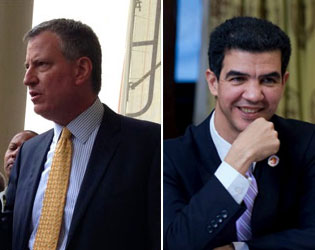
The City Council wants Mayor de Blasio to double funding for DOT capital projects to overhaul the city's most dangerous streets and save more lives, faster.
At a council budget hearing last week, transportation chair Ydanis Rodriguez called for additional funds in the executive budget for the "Great Streets" program. As of now the mayor's budget proposes $250 million for safety improvements on streets selected for the initiative: Queens Boulevard, the Grand Concourse, and Atlantic Avenue and Fourth Avenue in Brooklyn. Motorists killed 34 pedestrians, and seriously injured 215, on those four streets from 2009 to 2013.
In April, the City Council's preliminary budget called for a much larger "Great Streets" allocation of $500 million. Rodriguez and the council reiterated that demand in a statement published by the Daily News today. "With $250 million additional dollars we can more than double the amount of redesigned roadways," said Rodriguez. "Though the executive budget was a good start, the more money we put in, the more results we will attain."
De Blasio has shown some flexibility in budgeting for streets. Last month, the mayor announced an accelerated DOT repaving schedule at a conference on Staten Island, but did not mention Vision Zero.
We asked the mayor's office about the council Great Streets ask. De Blasio spokesperson Wiley Norvell sent us this statement:
The Great Streets initiative represents an unprecedented commitment in dollars, energy and swift action to transform perennially dangerous streets. It’s happening in real time: Queens Boulevard’s transformation will begin this summer. And Great Streets is one piece of a broader reengineering of our roadways, bringing safer intersections, protected bike lanes, and traffic calming to neighborhoods at an unprecedented clip. This is a year of aggressive implementation on Vision Zero, and we welcome the partnership of the Council, families and advocates as we continue this joint mission to end the loss of life on our streets. We are actively discussing the Council’s priorities as we approach budget adoption later this month.
Outside of the Great Streets program, DOT is planning 50 Vision Zero projects a year citywide, some no bigger than a single intersection. In April, Transportation Alternatives drafted a letter to de Blasio calling for an acceleration of these simpler, quicker street redesigns, to fix the 443 miles of the city's most dangerous streets more rapidly.
So far, Rodriguez -- not Speaker Melissa Mark-Viverito -- has been the public face of the council's efforts to increase Vision Zero funding. In April we asked Mark-Viverito's office about TA’s Vision Zero budget recommendations. We received no response.
Last week, Rodriguez and other council members also asked for DOT to devote more funds to Vision Zero education. Rodriguez pointed to the city's ubiquitous and graphic anti-smoking campaign as a good model for Vision Zero.





